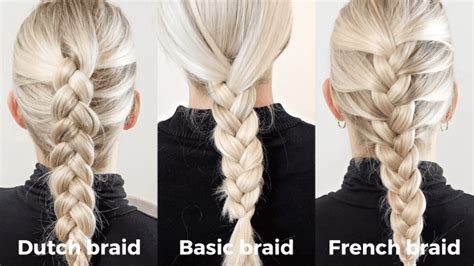Introduction
Braiding, an ancient art form dating back centuries, has evolved into an essential hair styling technique. Among the most popular braiding styles are Dutch braids and French braids, each offering their own unique aesthetic and functionality. This comprehensive guide will delve into the intricacies of these two iconic braids, exploring their similarities, differences, and practical applications.

Similarities:
1. Three-Strand Base:
Both Dutch and French braids are constructed using three strands of hair, creating a distinct interlaced pattern.
2. Versatility:
These braids are highly versatile and can be effortlessly incorporated into various hairstyles, ranging from intricate buns to elegant ponytails.
3. Dimensional Texture:
The overlapping strands in both braids add depth and dimension to the hair, creating a visually appealing texture.
Differences:
1. Starting Point:
Dutch braids originate from the scalp, where the strands are separated from the top of the head. French braids, on the other hand, begin closer to the forehead, with a small section of hair gathered near the hairline.
2. Direction of Weaving:
Dutch braids are characterized by their “inside-out” weaving technique, where the strands are crossed under each other. Conversely, French braids employ an “over-under” weaving method, crossing the strands over one another.
3. Thickness:
Due to their starting point and weaving direction, Dutch braids tend to appear thicker and more pronounced, while French braids result in a flatter, more delicate look.
Practical Applications:
1. Endurance Braids:
Both Dutch and French braids are known for their durability, making them excellent choices for athletes, performers, or individuals seeking a long-lasting style.
2. Heat Protection:
These braids act as protective barriers, safeguarding hair from heat damage caused by styling tools or sun exposure.
3. Hair Growth Enhancer:
The gentle tension created by braiding can stimulate blood flow to the scalp, potentially promoting healthy hair growth.
Why It Matters:
The choice between Dutch braids and French braids depends on personal preference and the desired aesthetic. However, understanding their key differences can empower individuals to select the most suitable braid for their unique style and hair type.
Benefits:
Dutch Braids:
- Thicker and more voluminous
- Create a more defined, textured look
- Ideal for thick, unruly hair
French Braids:
- Flatter and more delicate
- Produce a softer, romantic effect
- Suited for finer, smoother hair
Tips and Tricks:
1. Sectioning the Hair:
Proper sectioning is crucial for achieving a clean and even braid. Divide the hair into even sections parallel to the part line.
2. Tension Control:
Maintaining consistent tension throughout the braiding process is essential. Avoid pulling too tightly or loosely to prevent unevenness or hair damage.
3. Smoothing the Edges:
Use a wide-toothed comb or hair brush to gently smooth the edges of the braid for a polished finish.
Effective Strategies:
1. Practice Makes Perfect:
Braiding proficiency requires practice. Dedicate time to mastering the technique for flawless results.
2. Use Quality Products:
High-quality hair products, such as hairspray or mousse, can enhance the hold and longevity of the braids.
3. Variation:
Experiment with different braid sizes, patterns, and accessories to create unique and eye-catching hairstyles.
Table 1: Characteristics of Dutch and French Braids
| Characteristic | Dutch Braid | French Braid |
|---|---|---|
| Starting Point | Scalp | Near hairline |
| Weaving Direction | Inside-out (under) | Over-under |
| Appearance | Thicker, more textured | Flatter, more delicate |
Table 2: Benefits of Dutch and French Braids
| Benefit | Dutch Braid | French Braid |
|---|---|---|
| Volume Enhancement | Yes | No |
| Textured Effect | Yes | No |
| Heat Protection | Yes | Yes |
| Hair Growth Stimulation | Yes | Yes |
Table 3: Applications of Dutch and French Braids
| Application | Dutch Braid | French Braid |
|---|---|---|
| Endurance Braiding | Yes | Yes |
| Heat Styling Protection | Yes | Yes |
| Hair Growth Enhancement | Yes | Yes |
Table 4: Tips and Tricks for Braiding
| Tip | Description |
|---|---|
| Sectioning | Divide hair into even sections for a clean braid. |
| Tension Control | Maintain consistent tension throughout the braiding process. |
| Smoothing the Edges | Use a wide-toothed comb or hair brush to smooth the braid’s edges. |
| Practice | Dedicate time to practicing the braiding technique for proficiency. |
Conclusion:
Dutch braids and French braids offer a spectrum of aesthetic and practical benefits, empowering individuals to create diverse and captivating hairstyles. Understanding their similarities, differences, and appropriate applications enables one to select the perfect braid for their unique style and hair type. With practice and creativity, the art of braiding becomes an invaluable tool for expressing personal style and enhancing hair health.
